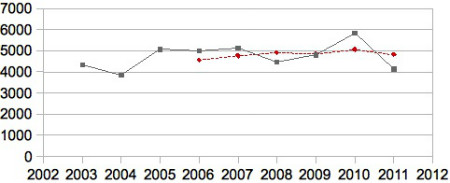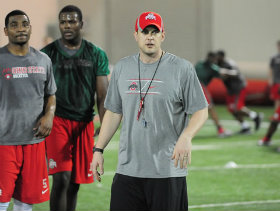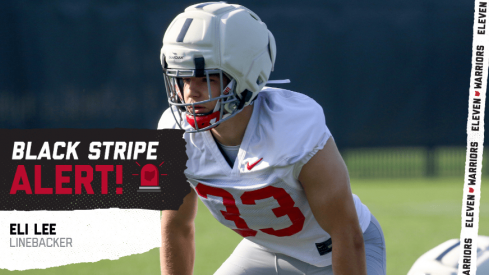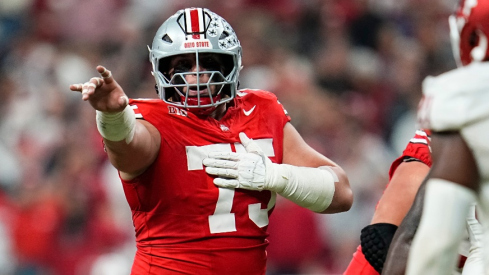We've talked a lot before about how poor Ohio State's offense was last year - relative to both what we're used to and to every other offense in college football.
The numbers - 115th out of 120 FBS teams in passing, and 107 in total offense - don't lie: last year was a terrible campaign, but thankfully it was an aberration.
I don't intend to dwell on last year's numbers, because it's likely commentators will have that covered in every single broadcast you hear this season.
 Urban's offense will surely bring a deluge of points
Urban's offense will surely bring a deluge of pointsInstead, we Buckeye fans find ourselves on the dawn of a new era in Ohio State football. Urban Meyer has returned to lead the Buckeyes and he's hired an offensive coordinator that has more than "Dave," "ISO" and a play action pass.
Essentially, we can be optimistic because simple competency in the passing game would be a huge improvement. Case in point:
Herman, who will leave play-calling duties to Meyer, deemed them a “2” on a scale of 1-10 following spring practice. But they’ve already improved by 100 percent in a handful of fall get-togethers."Light years,” said Herman, describing the improvement. “We can actually throw and catch a football. We are still not real good, but we are still a lot better than we were at the end of the spring, which is a testament to our guys and how much they worked in the offseason."
Just going from a "2" to a "4" can be considered opening the floodgates compared to last year's offense, but what exactly does a "4" look like?
Ohio State in the Tressel Era
Our baseline expectations for next year should be first based on what Ohio State has done in the past decade. Urban will undoubtedly be compared against Ohio State's last best coach ever - Jim Tressel.
Run-based, field position-winning Tresselball was never flashy. After Ohio State's second defeat against USC in the Shoe, Chris Brown wrote:
Jim Tressel is the closest thing we have to that Woody Hayes, Bo Schembechler style. This is not to say power running is gone, but the absolutely ridiculous idea that you can beat Southern Cal by running the same power play -- what Tressel calls "dave," with a pulling guard and a fullback who kicks out the defensive end -- over and over again, is to "live in the deep dark past.
Those are definitely harsh words (though not Chris's worst in the article), but to Tress's credit, the offense did show some signs of innovation in subsequent years. What it lacked was mostly consistent application of these new strategies.
Looking at Ohio State's offense over the Tressel-era, I'm struck by a couple of things. The below graph shows Ohio State's total offense from 2003-2011, with the red dotted line as a rolling 4-year average.

Tressel-led offenses typically suffered a big dip in overall production with every quarterback transition. The 2004 team lost Craig Krenzel, the 2008 team saw Pryor overtake Boeckman early in the season, and last year saw the unexpected departure of Pryor and the way-too-slow advancement of Braxton to the starting spot.
Tress's teams averaged 2321 yards rushing and 2293 yards passing per season. Last year was clearly an outlier for Ohio State offenses, though it's also clear that Bollman teams never had prolific offenses apart from the 2006 and 2010 years (just look at the variation in Quick Strike scores!).
These basic trends make me believe that next year's offense would have improved significantly, even without a Mensa-genius starting as offensive coordinator. After each dip year (2003, 2004, 2008), the following year's offense improved by ~350-500 yards passing (rushing yards are fairly constant, except for the Lydell Ross years).
If this upcoming season were another Tressel team, we might be happy with something like 2200 yards passing for Braxton and 2300 yards on the ground between the backs.
2200 yards through the air is comparable to what Pryor put up his sophomore year. While Pryor had more yards through the air his freshman campaign than Braxton did, much of that had to do with number of attempts and the fact that Braxton wasn't given the full reins to the offense until relatively later in the season.
Essentially, if we hadn't spent half of 2011 watching Bauserbombs into B-Deck, it's possible (and likely) that Braxton's numbers would more closely approximate Pryor's freshman year. If we can all remember, expectations for Pryor's passing were sky-high following his freshman year, and he regressed in many ways (the Quick Strike score again reflects this).
Braxton is a much different player than Pryor, with a sharper release and cleaner throwing motion. While his footwork was severely lacking according to Herman in the spring, his accuracy should improve significantly with adequate coaching. His 2012 numbers will reflect this improvement.
| Year | Quick Strike | Passing Yards | cmp% | RUsh Yards |
|---|---|---|---|---|
| 2003 | 0.374 | 1639 | 57 | 1639 |
| 2004 | .386 | 2105 | 54 | 1745 |
| 2005 | .485 | 2708 | 65 | 2360 |
| 2006 | .548 | 2791 | 65 | 2208 |
| 2007 | .462 | 2565 | 64 | 2553 |
| 2008 | .444 | 1953 | 60 | 2502 |
| 2009 | .428 | 2257 | 55 | 2540 |
| 2010 | .562 | 2971 | 65 | 2861 |
| 2011 | .393 | 1651 | 51 | 2485 |
The New Blood: Meyer and Herman
As Ross has previewed extensively, Urban's offense will consistently stress defenses by providing a quarterback run threat that will equalize defenses' numbers advantage on every play. While Pryor certainly presented a running threat to defenses, the actual offense was too strategically schizophrenic to consistently negate opposing defenses' numbers advantages. Ohio State will still utilize a power-run offense, but
The difference is that Meyer runs these plays in multiple directions from the spread, with quarterback reads and options built in. Therefore, all 11 defenders remain threatened even when they see initial run action.
Additionally, we can expect to see extensive use of the no-huddle and packaged plays, greatly improving the passing game's sophistication. These schematic changes will set Braxton up for success in ways that previous "multiple" -type offenses didn't.
Even without all of these schematic additions, any improvement would look extraordinary, simply because of how poor last year's offense looked. Nevertheless, we can look at how Urban and Tom Herman's offenses performed during their respective first years at Florida and Iowa State.
Urban's first year at Florida wasn't entirely representative of his offense - Chris Leak was definitely not his ideal quarterback like Tebow would be - but Leak nonetheless managed 2639 yards through the air. The tailback committee averaged 147 yards per game, which is comparable to Tressel's 2003 and 2004 squads.

Herman's Iowa State teams, however, totaled 2338 on the ground and 2403 yards through the air in his first year at Iowa State. Herman's offenses didn't really get rolling until last season, when Iowa State hung 44 on Oklahoma State. As Kyle reported, his achievements at Rice were even more impressive:
During the 2008 season, Rice ranked in the Top 10 nationally in passing offense, scoring offense and total offense. Rice scored more than 41 points per game compared to 18 the following season without Herman.
While it might look like we shouldn't expect a record-setting season based on Meyer and Herman's respective first years, these offenses weren't close to the "final product" because Meyer in particular lacked a quarterback run-threat with Leak.
Tebow's first year as a starter (his Heisman year) might provide a better point of reference: Tebow threw for over 3286 yards and the team rushed for an average of 200 yards per game. I'm not predicting that Braxton wins the Heisman just yet, but there's no debating that he has a higher ceiling as a passer than Tebow.
Based on the new offense's schematic advantages and the fact that Braxton gains a true quarterback coach, and in spite of the difficulties in implementing a new offense, we might expect something like 175-200 yards per game on the ground and anywhere from 2500-3000 passing yards.
putting it all together
Should the upcoming year's offense meet the expectations set by previous seasons at Ohio State, Meyer at Florida or Herman at Iowa State, we'll likely be ecstatic with anything over 2200-2500 yards passing and 2400 yards on the ground.
It's worth repeating that these numbers are approximations and are roughly based on previous years. However, it's clear the 2012 Buckeye squad is a different animal than any other, with a different quarterback, new innovations, and different circumstances. Regardless, Meyer, Herman, and Tressel's previous offenses will still form the context that we will use to evaluate the upcoming season.
Those base-line numbers wouldn't be close to record-setting. Oregon's 2011 offense, which was fourth-best in the country in total offense, totaled 4189 rush yards and 3130 pass yards. Yet even those numbers would seem like an absolute deluge of points and offensive firepower after last year.
Last year's group set the bar pretty low - unacceptably low for any team, let alone a Meyer and Herman coached offense. Here's to Braxton and company clearing that mark with ease.



